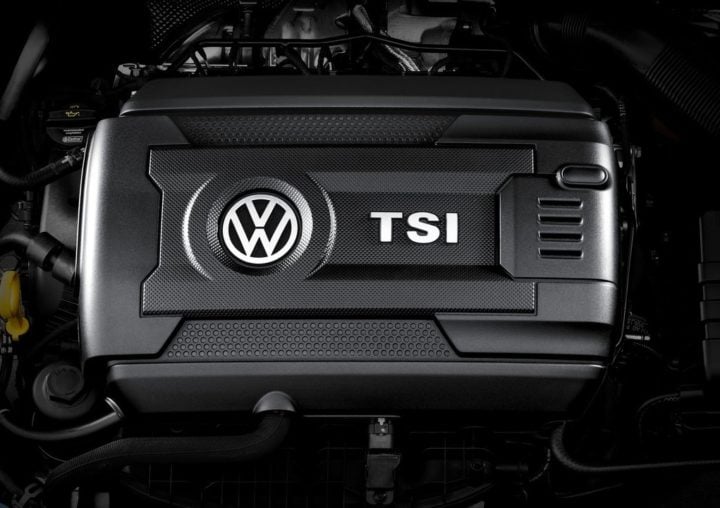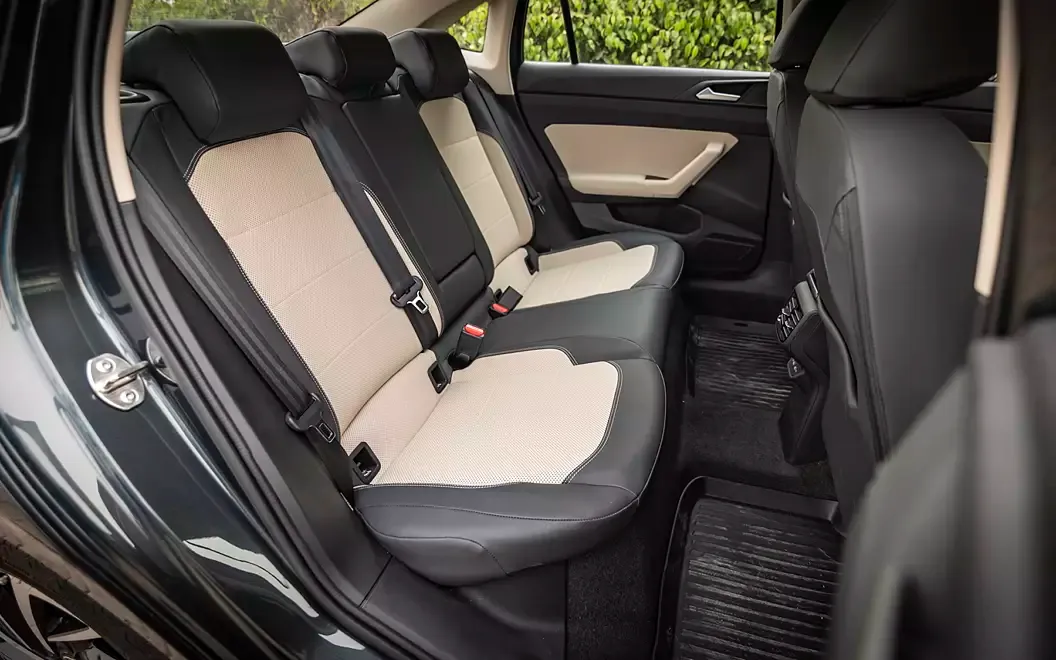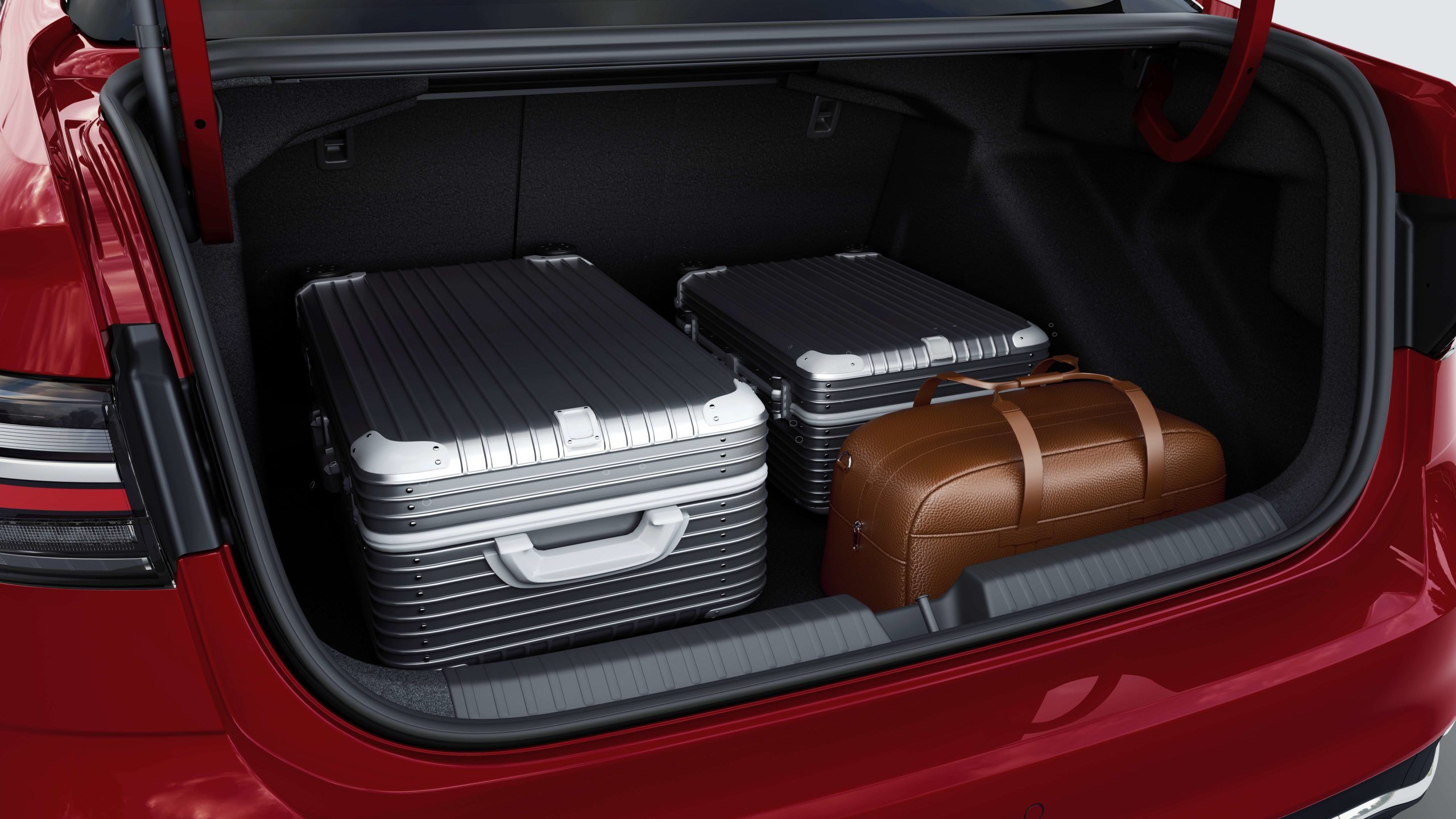
Volkswagen Virtus
₹11.56 Lakh - 19.40 Lakh
Check on road price




Latest Update: In February 2025 customers can get total benefits of up to ₹1.90 lakh and Scrappage Benefit of up to ₹20,000. This offer includes variants like
Variant | Benefits (Up to) |
Highline 1.0L TSI AT | ₹1.90 lakh |
Topline 1.0L TSI AT | ₹1.62 lakh |
Highline 1.0L TSI MT | ₹1.31 lakh |
GT Plus 1.5L TSI DSG Sport | ₹95,000 |
GT Line 1.0L TSI AT | ₹83,000 |
Introduction
Volkswagen Virtus is a midsize segment sedan based on VW’s MQB A0-IN platform. Moreover, it shares this platform with Skoda Slavia.
Variant and Colour
VW Virtus is available in 7 different colours i.e. Lava Blue, Wild Cherry Red, Curcuma Yellow, Candy White, Rising Blue, Reflex Silver and Carbon Steel Grey. Customers can also choose from 6 different variants i.e. Comfortline, Highline, Topline, GT, GT Plus and GT Edge.
Seating Capacity and Boot Space
Volkswagen Virtus can accommodate 5 adults. Its boot capacity stands at 521 litres.
Fuel Type and Mileage
Volkswagen Virtus comes in 2 different trim lines i.e. Dynamic Line and Performance Line. The Dynamic Line is offered with a 1 litre TSI petrol engine which produces 115 PS of power and 178 Nm of torque. The Performance line is offered with a 1.5 litre TSI petrol engine producing 150 PS of power and 250 Nm of torque. On the mileage front, the 1 litre engine delivers 20.08 km/l in manual transmission and 18.45km/l in automatic transmission. Also, the 1.5 litre engine delivers 18.88 km/l in manual transmission and 19.62 km/l in automatic transmission.
Transmission
The 1 litre TSI petrol engine can be paired with a 6 speed manual transmission or a 6 speed torque converter automatic transmission. The 1.5 litre TSI petrol engine can be paired with a 6 speed manual or a 7 speed DSG automatic transmission.
Safety Features
Similar to its cousin, the Skoda Slavia, the Volkswagen Virtus is also a Global Ncap 5 star rated vehicle. It scored 5 stars in both the adult occupant and child occupant protection. On the safety features front, the VW Virtus comes equipped with ABS, EBD, electronic stability program, brake assist, traction control system, tyre pressure monitoring system, etc. It also offers 6 airbags.
Dashboard and Entertainment Features
VW Virtus comes loaded with a number of features like a 10 inch infotainment system, a 7 inch instrument cluster, single pane sunroof, front ventilated seats, wireless charging, wireless android auto/apple car play, 8 speaker audio system, etc.
Ground Clearance and Dimension
On the dimension front, it is 4561 mm in length, 1752 mm in width and 1507 mm in height. Its ground clearance stands at 179 mm.
Rivals
The VW Virtus competes with other mid size segment sedans like Skoda Slavia, Honda City, Hyundai Verna and Maruti Suzuki Ciaz.
 |  |  |  |  |  |  |
| Volkswagen Virtus | Skoda Slavia | Hyundai Verna | Honda City | Volkswagen Taigun | Hyundai Creta | Skoda Kushaq |
| ₹ 11.56 - 19.40 Lakh | ₹ 10.49 - 18.39 Lakh | ₹ 11.07 - 17.55 Lakh | ₹ 11.86 - 16.59 Lakh | ₹ 11.80 - 21.10 Lakh | ₹ 11.11 - 20.50 Lakh | ₹ 10.99 - 19.11 Lakh |
Rating | ||||||
4/5 | 4/5 | 4/5 | 4.1/5 | 3.9/5 | 4.6/5 | 4.1/5 |
Engine (cc) | ||||||
| 999 cc - 1498 cc | 999 cc - 1498 cc | 1482 cc - 1497 cc | 1498 cc | 999 cc - 1498 cc | 1482 cc - 1497 cc | 999 cc - 1498 cc |
Airbags | ||||||
| 6 | 6 | 6 | 4 - 6 | 6 | 6 | 2 - 6 |
Mileage (ARAI) | ||||||
| 20.8 kmpl | 20.32 kmpl | 20 kmpl | 17.8 kmpl | 19.01 kmpl | 17.4 kmpl | 19.76 kmpl |
Max Power(bhp@rpm) | ||||||
| 114 bhp @ 5000-5500 rpm | 114 bhp @ 5000-5500 rpm | 158 bhp @ 5500 rpm | 119 bhp @ 6600 rpm | 148 bhp @ 5000-6000 rpm | 113 bhp @ 6300 rpm | 114 bhp @ 5000-5500 rpm |
Fuel Type | ||||||
| Petrol | Petrol | Petrol | Petrol | Petrol | Petrol | Petrol |
NCAP Rating | ||||||
| 5 Star (Global NCAP) | 5 Star (Global NCAP) | 5 Star (Global NCAP) | 5 Star (ASEAN NCAP) | 5 Star (Global NCAP) | Not Tested | 5 Star (Global NCAP) |
Transmission | ||||||
| Automatic / Manual | Automatic / Manual | Manual / Automatic | Manual / Automatic | Automatic / Manual | Automatic / Manual | Automatic / Manual |
| Currently Viewing | Virtus vs Slavia | Virtus vs Verna | Virtus vs City | Virtus vs Taigun | Virtus vs Creta | Virtus vs Kushaq |

The Virtus is powered by the same engine as the Taigun. So you have a 1.0-litre TSI engine, and a 1.5-litre TSI Evo engine. The figures are impressive: 148bhp and 250Nm of torque, with dynamic cylinder cut-off technology. The seven-speed DSG transmission handles transmission chores, and unlike Slavia, there is no manual option with this engine.
The TSI Evo motor feels polished on the move, with outstanding throttle response. You only need a dab to get past slow-moving traffic. That creates the sense that the 1.5-litre engine will surprise you when you eventually touch the accelerator.
However, this is not the case. Acceleration does not strike like a hammer; rather, it is linear and gains speed quickly. Volkswagen claims a 0-100kmph speed of 9.0 seconds.

VW says it is also fuel-efficient, with a great number of 18.67kmpl, thanks to active cylinder cut-off technology The seven-speed transmission works perfectly. It offers rapid up and down adjustments and is a delight to use with the paddle shifters.

There's no denying that the Virtus is a looker, especially the GT model . Starting with the front, this is a bold-looking sedan. The smoked LED headlights and integrated DRLs compliment the compact LED headlights, which are matched by the single slatted grille.
The true appeal, though, is the front air dam region, which gives it Sylvester Stallone's jawline. The air dam region, as shown, is a combination of chrome and piano black inlays, and it also gets halogen fog lights.
Alloy wheels with two colors are on the side. Notable features include gloss black alloy wheels and a "GT" badge on the front fender on the top-tier GT model. The split tail lamps in the back have a smoke effect, and the 'Virtus' lettering is more clearly displayed in the middle of the boot.
More black can be seen on the side in the shape of the 16-inch razor shiny black alloy wheels. This is also a very long automobile, and it is 20mm longer than the Slavia, which is built on the same chassis, making it the longest car in its class.
The Virtus, like the Slavia, is a high-riding sedan, which means it has a large 179mm of ground clearance, which may appear to be an eyesore but offers the car SUV-like poor road capabilities. Moving to the back, you'll see these stylish LED tail lights.
The small black lip spoiler adds a sporty touch to the rear, while the blacked-out region below with a chrome inlay adds even more contrast.
Overall, we believe the Virtus looks fantastic and is the sportiest looking car in its class.

Speaking of the interiors, if you fell for the external design, the sleek interior design will not let you keep your eyes off of it.
We loved how Volkswagen created this dashboard to seem like a single slab, especially with the color coded outline, which adds a lot of flair. These two central air conditioning vents appear to be out of place with the flowing dashboard design.
While the dashboard looks wonderful, we believe that adding soft-touch materials would have given it a more premium feel.

When it comes to the seats, the padding is a tad firm, but that will help make lengthy rides more pleasant. Nonetheless, it provides enough support all around, and adjusting to the optimal driving posture is simple.
There is also plenty of legroom in the back. It's not ideal for three people because of the higher and smaller centre seat. Additionally, under-thigh support might be improved.

The boot space, on the other hand, is great. It has the same capacity as the Slavia but much more than the City, and a 60:40 split or totally folding the rear bench provides far more baggage room than any SUV.
The Virtus comes with an eight-inch digital cockpit, a 10-inch infotainment system with wireless Apple CarPlay and Android Auto, eight speakers, a sunroof, wireless charging, smart touch climatronic A/C, ventilated front seats, and other amenities.

Despite the lack of fresh releases, the market for mid-size cars, or this sector, is rising, according to both Skoda and VW. The Virtus aims to meet this need by providing a credible alternative to the popular Honda City and its brother from another mother, the Skoda Slavia.
The Virtus has a number of positive attributes. It's the largest car in its class, it looks luxurious, and it looks sporty in this GT model. It also offers the capacity and functionality of an SUV, with foldable seats and great ground clearance, as well as a large feature list and performance to match.
When it comes to the price point of VW Virtus, the price starts at Rs. 10.6 lakh for the base We believe Virtus costs would start at Rs 11.31 Lakh for the base 1.0-litre model and goes up to Rs 18.41 lakh for this top-spec GT variant. And based on what it brings to the table, we believe the Virtus has all the qualities of a winner.







































































































| Month | Sold Units |
|---|---|
| May' 2025 | 1,707 units |
| Apr' 2025 | 1,605 units |
| Mar' 2025 | 1,947 units |
| Feb' 2025 | 1,837 units |
| Dec' 2024 | 2,257 units |
| Nov' 2024 | 1,457 units |
Volkswagen Virtus delivers mileage 18.45 to 20.8 kmpl.
Volkswagen Virtus starting price is 11.56 Lakh (plus registration, insurance & other costs) for the base model. while the Volkswagen Virtus top model price is Rs.1939900 (plus registration, insurance & other costs).
Click Here to check OnRoad Price ofVolkswagen Virtus.